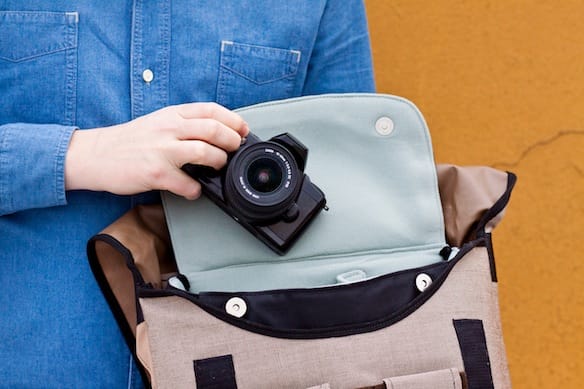
Image credit: Photojojo.
Buying a Camera Bag
by Keith Thomson
So you finally purchased a camera! Good for you! I wish you the best in this new pursuit of photography as a hobby, or maybe you have professional aspirations, but now, how do you carry your camera, and maybe also other gear?
There are bags for every style and size of camera, but there are a few basic questions that you may want to have in mind when choosing a bag: Will it FIT your camera or other gear? Is it COMFORTABLE to carry? Will the PADDING protect your camera from impact? Will it SHIELD from potentially damaging elements, like water, moisture, dust, dirt etc. Does it have STORAGE, zippered or Velcro, for accessories? For this guide, I’m going to skip the idea of buying a leather bag. They may be more stylish, but they most often offer far less protection, so I wouldn’t recommend them.
Types of Camera Bags
If you’re looking for a COMPACT CAMERA BAG, you have the option of a “soft” case, usually made of foam and nylon or a “hard” case, usually made with a molded interior with a soft lining to avoid abrasion and scratching. The “hard” cases are crush resistant and often less bulky. Compact camera bags are often used only as a protective shell and stored in another, larger bag, but you can also find ones that have a neck strap or ones that have belt loops. You can find these types of bags for as little as $10 and up to about $30.
SLR BAGS offer the most variety of option and are usually run between $50-$100. SLR users need to fit at least one lens, maybe more, or other equipment. The RECTANGULAR SHOULDER BAG is most common and is also associated with camcorders. The top is opened, like a box, for easy access. They often have more than one compartment that can be personalized by adjustable, cushioned walls.
The TOPLOADER or TRIANGULAR BAG is meant to hold one camera with an attached lens. These are often used by travelers and worn over the shoulder, resting against the side body for easy access. They come in many different sizes, so you must be sure that it fits your camera and the lens you have attached to it. The most common ones are made deep enough for your camera and a mid-range zoom, but not a telephoto lens. Also, if attach an external battery grip to your camera body, it adds to the width of your camera, so think about what you plan on putting in there.
A WAIST BAG offers easy access. As the title implies, they secure around the waist, not the shoulder, thus leaning the support more to the lower body. They offer multiple compartments for carrying an extra lens or two or maybe a flash unit. These protrude from the body, keeping your camera close at hand, but also eliminate the discretion that you’ve got a camera there.
Camera Backpacks
I call a camera BACKPACK a “gear bag” because these are made to hold an assortment of cameras and accessories. They can range from about $100 up to a few hundred dollars. These are used by professional photographers or advanced amateurs who are traveling with a variety of gear. They have multiple, adjustable compartments, internal and external pockets, laces, internal or external netting, a laptop compartment, straps and other securing fixtures, for say, a tripod. For example: for a professional job, I pack two camera bodies, three or four lenses, two flash units, an off camera chord, back-up CF cards, back up batteries for both camera bodied, pen and paper, and whatever else I think I might need for that particular job. I consider weather protection highly important for this type of bag and would never purchase one that didn’t have an all weather cover. After all, these are made to hold thousands of dollars in gear.
Conclusion
Many photographers have more than one bag because each type has its uses and each photographer has their preferences. When looking for a bag, I’d recommend thinking, not only about what camera, lens and gear you have now, but what do you think you may want to have in the future? That way, you’ll be better prepared as your photography system grows and changes.



